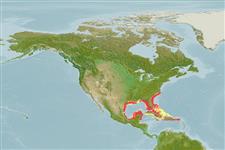Environment: milieu / Klimaatzone / Diepte / distribution range
Ecologie
marien rifbewoner; standvastig; diepte 2 - 92 m (Ref. 9710), usually 5 - 25 m (Ref. 9761). Subtropical; 35°N - 18°N, 100°W - 64°W (Ref. 55264)
Western Atlantic: Bermuda, Bahamas and off southern Florida, USA to the Gulf of Mexico, including Yucatan, Mexico (Ref. 26938).
Grootte / Gewicht / Leeftijd
Maturiteit: Lm ? range ? - ? cm
Max length : 45.0 cm TL mannelijk / geslacht onbekend; (Ref. 4858); common length : 35.0 cm TL mannelijk / geslacht onbekend; (Ref. 3797)
Soft parts of dorsal and anal fins and caudal fins have wide yellow margins. Dark spot on forehead lacks electric blue ring. Juveniles blue, banded, with last prominent band straight (Ref. 26938). The pectorals are blue basally, clear distally, with a broad yellow band separating the two colors; the pelvic fins are light yellow (Ref. 13442).
Body shape (shape guide): short and / or deep; Cross section: compressed.
Inhabits rocky or coral reefs (Ref. 9710). Juveniles in channels and on inshore reefs (Ref. 9710). Feeds primarily on sponges (Ref. 9710). Small juveniles do well in aquariums once they begin to accept food.
Levenscyclus en paargedrag
Maturiteit | Voortplanting | Paaien | Eieren | Fecunditeit | Larven
Allen, G.R., 1985. Butterfly and angelfishes of the world. Vol. 2. 3rd edit. in English. Mergus Publishers, Melle, Germany. (Ref. 4858)
Status op de Rode Lijst van het IUCN (Ref. 130435: Version 2025-1)
Gevaar voor de mens
Reports of ciguatera poisoning (Ref. 30303)
Gebruik door de mens
Visserij: van minder commercieel belang; Aquarium: Commercieel
Tools
Speciale rapporten
Download XML
Internetbronnen
Estimates based on models
Preferred temperature (Ref.
123201): 23.4 - 27.4, mean 24.6 °C (based on 208 cells).
Fylogenetische diversiteitsindex (Ref.
82804): PD
50 = 0.5078 [Uniqueness, from 0.5 = low to 2.0 = high].
Bayesian length-weight: a=0.03162 (0.01607 - 0.06223), b=2.88 (2.71 - 3.05), in cm total length, based on LWR estimates for this species & (Sub)family-body (Ref.
93245).
Trofisch niveau (Ref.
69278): 3.0 ±0.0 se; based on diet studies.
Weerstandsvermogen (Ref.
120179): laag, minimale populatieverdubbelingstijd 4,5-14 jaar (Preliminary K or Fecundity.).
Fishing Vulnerability (Ref.
59153): Low to moderate vulnerability (35 of 100).
🛈
Nutrients (Ref.
124155): Calcium = 23.2 [10.6, 42.9] mg/100g; Iron = 0.487 [0.280, 0.845] mg/100g; Protein = 19 [18, 20] %; Omega3 = 0.151 [0.087, 0.259] g/100g; Selenium = 18.6 [8.8, 40.2] μg/100g; VitaminA = 35.5 [8.6, 142.2] μg/100g; Zinc = 0.782 [0.509, 1.170] mg/100g (wet weight);
